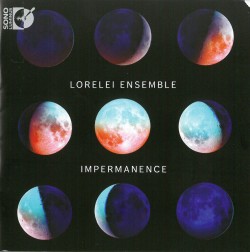 Impermanence
Impermanence
Lorelei Ensemble
Sono Luminus DSL-92226 (sonoluminus.nativedsd.com)
Impermanence is an album on a mission. The liner notes offer a lengthy essay by Beth Willer, artistic director of the nine-voice Boston-based women’s vocal group, Lorelei Ensemble. She mentions the migration of peoples, pilgrimage, the essential impermanence of existence, and the function of music “as a container of meaning,” among other topics.
Examining the old-juxtaposed-with-the-new-repertoire approach of this album, it can be grouped into four categories, beginning with the 12th-century song Portum in ultimo. Among the earliest of works in polyphonic notation, it’s preserved in a book meant for pilgrims travelling along the Camino de Santiago de Compostela.
The much larger second group consists of 15th-century motets by Guillaume Du Fay, the renowned Franco-Flemish composer, plus motets from the contested “anonymous” Turin Codex J.II.9 of Cypriot-French origin. The J.II.9 songs with their polyphonic freedom and piquant resultant harmonies reflect the remarkable fluidity of the people and cultures between the European mainland and the 15th-century French court in Cyprus.
In a third group falls the choral work Tsukimi (Moon Viewing 2013) by American composer Peter Gilbert, eliciting the Japanese celebration of the full moon in ancient Heian era poems. Eight individual songs, evocatively rendered by Gilbert, are interspersed among the motets and two Toru Takemitsu (1930-1996) Vocalises. Constituting the fourth group, these songs are from Takemitsu’s larger composition Windhorse, depicting Tibetan nomads.
The album closes with Takemitsu’s Vocalise II. It offers a satisfying tonal closing, the core of which is a quote from a Bantu lullaby, resolving the bracing modernist harmonies heard just beforehand. To my ear Lorelei Ensemble’s ambitious concept album works superbly.



